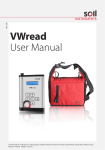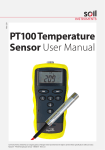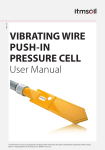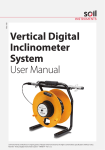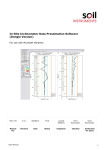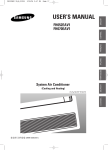Download Smart In-Place Inclinometer (IPI) User Manual
Transcript
Man 233 Smart In-Place Inclinometer (IPI) User Manual Soil Instruments Limited has an ongoing policy of design review and reserves the right to amend these specifications without notice. Man233 - Smart In-Place Inclinometer (IPI) - MN0814 - Rev1.0.1 1 What’s this manual about? This manual tells you about the Smart In-Place Inclinometer (Smart IPI) and how to use it to take measurements of lateral displacement within a borehole. Who does this apply to? QUESTION 2 Installers, field engineers and technicians who need to measure lateral displacement within a borehole. Welcome! Thank you for choosing the Smart In-Place Inclinometer (IPI). This manual has been written to help you utilise all of the functions of the Smart IPI. Please read this manual thoroughly before use to help avoid any problems and keep it handy when using the Smart IPI. Smart In-Place Inclinometer (IPI) A Smart In-Place Inclinometer (Smart IPI) system is used to remotely monitor lateral displacement within a borehole. The Smart IPI has been designed to supersede traditional IPI systems; with advanced single cable technology and new mechanical design, the Smart IPI is seen as a new product rather than just an improvement to the old. The Smart IPI System comprises in its most basic form a Data Acquisition system, a Sensor Interface Module (S.I.M), one Top Support Assembly, up to 39 Smart IPI Sensors and one Terminating Sensor. Contained within the Smart IPI Sensor body is a PCB and two MEMS sensors. The data is transmitted via the single cable that runs from the bottom of the borehole at the Terminating Sensor, up to the top of the borehole through up to 39 standard sensors and the Top Support Assembly. This cable plugs into a Sensor Interface Module (S.I.M.) which is connected to a Datalogger, both housed together within an enclosure at the surface. Each Smart IPI Sensor is connected to the next using an Easy-Connect Coupling, starting with a Terminating Sensor and culminating in a Top Support Assembly with an easily adjustable setting bar. A Top Support spans the pre-installed casing which holds the Smart IPI in place in a vertical borehole, or maintains its position in a horizontal borehole. The Smart IPI incorporates a Support Wire System to aid with removal and to prevent loss or damage to the string of the Smart IPI Sensors, should the assembly slip or be accidentally dropped. 3 Contents PART I – OVERVIEW6 Introduction:8 Important Information8 Product8 Changes8 Warranty8 Disposal8 System Description9 Things You Need to Know About the Smart IPI System 9 Features9 Benefits9 System Components9 For Each Borehole You Will Need: 9 Per 40 Smart IPI Sensors You Will Need: 9 Smart IPI Terminating Sensor10 Smart IPI Sensor10 Top Support Assembly11 Sensor Interface Module (S.I.M.) 12 Smart IPI System12 Quick Start Guide to Installing the Smart IPI System 13 Before You Go to Site:13 When You Are in the Field: 13 PART II – DETAILED SMART IPI INSTALLATION GUIDE 16 Installing the Smart IPI 18 Tools Required18 How to Install Smart IPIs 18 Terminating Sensor and Support Wire 19 Connecting the Sensors21 Connecting & Lowering the First Sensors 22 Connecting & Lowering Subsequent Sensors 23 Last Sensor & Top Support Assembly 24 Sensor Interface Module (S.I.M) 25 4 PART III - DETAILED SENSOR INTERFACE MODULE (S.I.M.) GUIDE 26 Sensor Interface Module (S.I.M.) 28 Overview28 Status LEDs28 Connecting the Smart IPI String to the (S.I.M.) 29 Logger Control29 S.I.M. Wiring Code29 Power Requirements29 PART IV – APPENDICES30 Appendix A - Installation Sheet Example 32 Blank Installation Sheet33 Appendix B - Datalogger Wiring Diagram34 PRECISELY MEASURED instrumentation and monitoring 5 Part I – Overview 6 Contents This section contains the following topics. TOPIC Introduction: Important Information Product Changes Warranty Disposal System Description Things You Need to Know About the Smart IPI System Features Benefits System Components For Each Borehole You Will Need: Per 40 Smart IPI Nodes You Will Need: Smart IPI Terminating Sensor Smart IPI Sensor Sensor Top Support Assembly Sensor Interface Module (S.I.M.) Smart IPI System Quick Start Guide to Installing the Smart IPI System Before You Go to Site: When You Are in the Field: SEE PAGE 8 8 8 8 8 8 9 9 9 9 9 9 9 10 10 11 12 12 13 13 13 7 Introduction: Important Information The following symbols are used throughout the manual IMPORTANT INFORMATION QUESTION WARNING TIP ! Important: Failure to adhere to the warnings in this manual may result in network disruption and possible data loss. Failure to observe the warning may result in injury, product malfunction, unexpected readings or damage to the product that may invalidate its warranty. WARNING Tips give additional information that may be helpful when using the Smart In-Place Inclinometer (IPI) system. TIP PRODUCT CHANGES Soil Instruments has an on-going policy of design review and reserves the right to amend the design of their product and this instruction manual without notice. WARRANTY Refer to our terms and conditions of sale for warranty information. The batteries are a consumable item and are excluded from the warranty. DISPOSAL Products marked with the symbol are subject to the following disposal rules in European countries: • This product is designated for separate collection at an appropriate collection point • Do not dispose of as household waste • For more information, contact Soil Instruments or the local authority in charge of waste management. WEE/DE3326WV 8 System Description Things You Need to Know About the Smart IPI System FEATURES • Biaxial MEMS Sensors • Single cable system • Sensor strings give a readily automated profile of vertical or horizontal displacements • Factory allocated serial numbers • Onsite allocation of Sensor IDs • Mechanical and electrical connection rated IP68 to 2000 kPa • Accurate and precise measurements using MEMS sensors • Easy to automate using data acquisition system and ‘ARGUS’ monitoring software • Removes the need for manual monitoring • Fast onsite installation with minimal cable management System Components • Plug-and-play into Sensor Interface Module (S.I.M.) • Calibration factor stored in each sensor allow output in engineering units • Up to 40 Smart IPIs per borehole (including Terminating Sensor) • Ability to add to the network as and when required BENEFITS System Components FOR EACH BOREHOLE YOU WILL NEED: • • • • PER 40 SMART IPI SENSORS YOU WILL NEED: • 1 x Sensor Interface Module (S.I.M.) house in a Datalogger • Either mains power with battery backup (preferred), or 12V battery plus Solar/wind charging battery pack 1 x Terminating Sensor Up to 39 x Smart IPI Sensors 1 x Top Support Assembly 1 x Steel support wire 9 SMART IPI TERMINATING SENSOR The components of the Terminating Sensor are identified below: Sensor body containing MEMS Tiltsensors Easy-Connect Coupling (male end) Sprung wheel (A-) that engages into inclinometer casing keyways Support wire bracket Wheel assembly Fixed wheel (A+) positive direction of movement SMART IPI SENSOR The components of the Smart IPI Sensor are identified below: Sprung wheel (A-) that engages into inclinometer casing keyways Signal cable linking sensors Easy-Connect Coupling (male end) Sensor body containing MEMS Tiltsensors Fixed wheel (A+) positive direction of movement Gauge extension tube to next sensor 10 TOP SUPPORT ASSEMBLY The components of the Top Support Assembly are identified below: Threaded eyelet Adjustable setting bar M12 nuts M12 washer Top support Signal cable Eyelet Wheel assembly Gauge extension tube Easy-Connect coupling 11 SENSOR INTERFACE MODULE (S.I.M.) The Sensor Interface Module (S.I.M.) is identified below: SMART IPI SYSTEM A string of Smart IPIs, including the Terminating Sensor at the bottom and the Top Support Assembly at the top, is assembled on site and installed in a borehole. Each Smart IPI contains a Smart Control PCB, which processes the MEMS sensor signal to provide output in engineering units. The data is transmitted from each Sensor via a single CANbus to a Sensor Interface Module (S.I.M.) which is connected to a Datalogger, both housed within an enclosure located onsite. This combined system is used to power the Smart IPIs, configure and enumerate the Smart IPI network and transmit measurements from sensors, communicating data to the user. The data can be directly imported into ‘ARGUS’ monitoring software suite, a graphical user interface (GUI) that allows quick and easy data interpretation, enabling a fully automated system. 12 Quick Start Guide to Installing the Smart IPI System Follow the instructions outlined in this manual at all times to ensure correct installation and maintenance of the Smart IPI System. WARNING BEFORE YOU GO TO SITE: Please follow the steps outlined below to ensure the correct installation of the Smart IPI System. Please also refer to Part II – Detailed Smart In-Place Inclinometer Installation Guide in this manual for more details. STEP ACTION 1 Lay out all the components of the Smart IPI System and check all parts are present and correct and have not been damaged in transit. WHEN YOU ARE IN THE FIELD: STEP 1 2 Soil Instruments recommend an intermediate skill level for installing a Smart IPI System. ACTION Lay out all the components of the Smart IPI System in the correct order of installation. Determine the A+ (+mm) direction in which to install the Smart IPI Terminating Sensor; the fixed wheel facing towards the direction of movement and the sprung wheel away from the direction of movement. Once you have determined the A+ direction for the Smart IPI Terminating Sensor, all other Smart IPIs will orient in the same direction when connected together. IMPORTANT INFORMATION 3 Attach the support wire to the support wire bracket on the Terminating Sensor. Please refer to Part II – Detailed Smart In-Place Inclinometer Installation Guide - Attaching the Terminating Sensor and Steel Support Wire in this manual for more details. 4 Install the Sensor Interface Module (S.I.M.) and Datalogger within a reasonable distance from the top of the borehole. 5 Attach the Top Support to the Top Support Assembly. 6 Immediately before you lower the Smart IPI Sensor into the borehole, make a note on an installation sheet of its serial number, position in the string and depth. Repeat for all subsequent sensors. 13 If you are fitting the Smart IPIs into recently installed casing, you must take care to ensure that any hydration heat has dissipated before you install the Smart IPI Sensors. WARNING Immediately before you lower each sensor into the borehole, make a note on an installation sheet of its serial number, position in the string and depth. WARNING STEP ACTION 7 Lower the Smart IPI Terminating Sensor into the borehole, supporting the gauge extension tube with the Installation Support Tool to prevent the sensor from falling down the borehole. 8 Attach the next Smart IPI Sensor using the Easy-Connect Coupling. 9 Repeat with subsequent sensors, keeping the steel support wire free from snagging. 10 11 12 Attach the Top Support Assembly to the top of the last Smart IPI Sensor using the Easy-Connect Coupling, adjusting and locking the position of the Top Support using the M12 nuts. Using armoured cable, connect the cable from the string of Smart IPIs to the Sensor Interface Module (S.I.M) housed within the Datalogger enclosure. Start logging. Installing a string of Smart IPI Sensors without using a steel support wire can result in loss or damage of the string if the assembly slips or is dropped into the borehole accidentally. WARNING Ensure the cable does not become snagged stretched or kinked. The same applies to the support wire. WARNING 14 Easy-Connect Coupling Correctly Connected Incorrectly Connected 15 Part II – Detailed Smart IPI Installation Guide 16 Contents This section contains the following topics. TOPIC Installing the Smart IPI Tools Required How to Install Smart IPIs Terminating Sensor and Support Wire Connecting the Sensors Connecting & Lowering the First Sensors Connecting & Lowering Subsequent Sensors Last Sensor & Top Support Assembly Sensor Interface Module (S.I.M.) SEE PAGE 18 18 18 19 21 22 23 24 25 17 Installing the Smart IPI This manual assumes that you have already installed quality inclinometer casing. For details of suitable casing, please see Soil Instruments datasheets C9, C9-4 and C18. If you are fitting the Smart IPIs into recently installed casing, you must take care to ensure that any hydration heat has dissipated before you install the Smart IPI Sensors. WARNING TOOLS REQUIRED HOW TO INSTALL SMART IPIS • Length of 3mm steel support wire 5m longer than depth of borehole • M12 spanner (for adjustment and tightening of the Top Support) • M4 spanner (for adjustment and tightening of the support wire shackle clip) • Flat ended terminal screw driver (wiring) • Installation Support Tool An installed string of sensors (five shown in the example below) will be installed in the following way: (Bottom of borehole) 1. Smart IPI Terminating Sensor; wheel assembly with support wire bracket and support wire attached, Easy-Connect Coupling 2. Smart IPI Sensor; wheel assembly, gauge extension tube, Easy-Connect Coupling 3. Smart IPI Sensor; wheel assembly, gauge extension tube, Easy-Connect Coupling 4. Smart IPI Sensor; wheel assembly, gauge extension tube, Easy-Connect Coupling 5. Smart IPI Sensor; wheel assembly, gauge extension tube, Easy-Connect Coupling (Top of borehole) Top Support Assembly; Easy-Connect Coupling, gauge extension tube, wheel assembly, adjustable setting bar, Top Support, eyelet, support wire, shackle clip, signal cable Armoured cable Sensor Interface Module (S.I.M) Datalogger 18 Installing a string of Smart IPI Sensors without using a steel support wire can result in loss or damage of the string if the assembly slips or is dropped into the borehole accidentally. WARNING TERMINATING SENSOR AND SUPPORT WIRE The Terminating Sensor can be easily identified as it does not have a gauge extension tube and has a support wire bracket attached to the wheel assembly for attaching the support wire. Thread the support wire down through the first hole in the wire support bracket, loop around the underneath of the bracket and thread back up through the second hole. Feed the support wire through the bracket until there is a suitable length to attach to the full length of the support wire, ideally above the Terminating Sensor housing. Connect the free end of the support wire to the full length using the shackle clip provided. Once the support wire loop is adequately placed, tighten the M4 nuts securely with a spanner. Leave a suitable length of the end support wire protruding from the shackle clip and ensure the M4 nuts on the shackle clip are securely tightened. WARNING Terminating Sensor housing Support wire Shackle clip M4 nuts Support bracket Wheel assembly Support wire leading down to bracket Support wire leading up from bracket Tape or cable-tie the free end of the support wire to the gauge extension tube to prevent snagging. WARNING 19 Terminating Sensor with Gauge Extension Tube and Support Wire Support wire (leading to the top of the borehole) Support wire (end) Gauge extension tube Shackle clip Cable-ties Easy-Connect Coupling Sensor body Support wire bracket Sprung wheel (A-) Wheel assembly Fixed wheel (A+) 20 CONNECTING THE Push the Smart IPI connection into the Easy-Connect Coupling located SENSORS on the end of the gauge extension tube, making sure to align the slot on the Smart IPI with the notch on the Easy-Connect Coupling, then securely tighten the threaded barrel. Easy-Connect Coupling Correctly Connected Incorrectly Connected Immediately before you lower each sensor into the borehole, make a note on an installation sheet of its serial number, position in the string and depth. WARNING Please refer to Part IV – Appendices - Appendix A - Installation Sheet Example in this manual for more details. 21 CONNECTING & LOWERING THE FIRST SENSORS Please follow the steps outlined below to ensure the correct installation of the Smart IPI System. Soil Instruments recommend an intermediate skill level for installing a Smart IPI System. Join the Terminating Sensor to the first Smart IPI Sensor before you attempt to lower the sensors down the borehole. WARNING STEP ACTION Locate the A+ (+mm) direction of the Terminating Sensor; the fixed wheel should be facing towards the direction of movement and the sprung wheel away from the direction of movement. 1 Pick up the second Smart IPI Sensor and align the slot on the sensor end with the notch on the gauge extension tube end. Gently push together and tighten using the threaded barrel. Both these sensors are connected before they are lowered into the borehole. 2 Please refer to Part II - Detailed Smart IPI Installation Guide Connecting the Sensors in this manual for more details. Immediately before you lower each sensor into the borehole, make a note on an installation sheet of its serial number, position in the string and depth. WARNING STEP ACTION Immediately before you lower the sensors into the borehole, make a note on the installation sheet of their serial numbers, position in the string and depth. 3 Whilst holding the Terminating Sensor with one hand, gently guide the wheel assembly (bottom wheel first) into the borehole with the fixed wheel facing towards the A+ direction. Make sure that both wheels are correctly aligned in the keyways of the casing. Guide the wheel assembly of the second Smart IPI sensor into the borehole in the same manner as before and place the Installation Support Tool in the available slot directly underneath the second Smart IPI Sensor, just above the bolts where the sensor connects to the wheel assembly. 22 STEP 3 ACTION The Installation Support Tool spans the inclinometer casing, preventing the sensor from falling into the borehole, allowing you to fit subsequent sensors with ease. The Smart IPI Sensor can now rest safely in place on the Installation Support Tool. Take care to ensure that the wheels remain in the keyways of the casing and that they are not snagged by the support wire which should be free to move within the borehole. WARNING CONNECTING & LOWERING SUBSEQUENT SENSORS Pick up the next Smart IPI Sensor and align the slot on the sensor end with the notch on the gauge extension tube end. Gently push together and tighten using the threaded barrel as before, then raise to vertical and lower into the borehole, making sure that both wheels are correctly aligned in the keyways of the casing. Repeat this process until all except the last (top) sensors are installed, remembering to note the serial number, string position and depth for each sensor as you go. 23 LAST SENSOR & TOP SUPPORT ASSEMBLY STEP 1 The Top Support Assembly supports the Smart IPI string in a vertical borehole and maintains its position in a horizontal borehole. ACTION Attach the final gauge extension tube assembly to the last sensor using the Easy-Connect Coupling and tighten the threaded barrel. 2 Attach the adjustable setting bar to the wheel assembly using the eyelet on the gauge extension tube of the Top Support. 3 Measure the distance from the fixed wheel on the gauge extension tube of the Top Support Assembly to the required location for the Top Support (where it will rest within the top of the casing). 4 5 Place the Top Support over the adjustable setting bar, followed by the M10 washer and the M10 nut and thread down until you reach the previously measured distance. Raise the Top Support Assembly into a vertical position, as before, and lower it into the borehole until the Top Support reaches the top of the casing. 6 Centralise the Top Support and place securely within the casing. 7 Make any final adjustments to the length of the IPI string if needed before securely tightening the M10 nut. If the borehole is under depth, the top sensor may not fit fully into the borehole at the desired gauge length. If this happens, remove the last sensor and reposition the Top Support by moving it closer to the wheel assembly of the top sensor. IMPORTANT INFORMATION 24 9 Thread a second M10 nut over the adjustable setting bar until it reaches the first nut. Lock off the second nut securely against the first. 10 Thread the eyelet onto the top of the adjustable setting bar and tighten until it is secure. 11 Thread the steel support wire through the eyelet ensuring there is sufficient length to securely fit the shackle clip. 12 Fit the shackle clip to the support wire in the same way as it was attached at the Terminating Sensor. Top Support Assembly; eyelet with steel support wire and shackle clip SENSOR INTERFACE MODULE (S.I.M) The Sensor Interface Module (S.I.M.) is the link between the logger and the sensors within the borehole. The S.I.M. is housed with the Datalogger in an enclosure, which should be installed within a reasonable distance from the Smart IPI installation. Please refer to Part III – Detailed Sensor Interface Module Guide in this manual for installation details. 25 Part III Detailed Sensor Interface Module (S.I.M.) Guide 26 Contents This section contains the following topics. TOPIC Sensor Interface Module (S.I.M.) Overview Status LEDs Connecting the Smart IPI String to the (S.I.M.) Logger Control S.I.M. Wiring Code Power Requirements SEE PAGE 28 28 28 29 29 32 32 27 Sensor Interface Module (S.I.M.) OVERVIEW The Sensor Interface Module (S.I.M.) unit is the link between the Datalogger and the sensors within the borehole. The S.I.M. responds to commands sent to it by the logger in a question and answer format, processes the commands and then responds appropriately. The S.I.M. also monitors temperature and the voltage and current supply to the string of sensors, protecting them when necessary. STATUS LEDS On the front of the Sensor Interface Module (S.I.M.) are three LEDs to indicate the current status of the module; these are explained in the table below. NAME COLOUR STATE Constant off DESCRIPTION The module either has no power Status Green Slow blink The module is currently idle Fast blink The module is currently active Constant off Power to the sensor network is off Constant on Power to the sensor network is on Blinking Sensor string Current warning level (3Amp) Constant off No fault Constant on A fault has occurred Blinking Current limit reached (4Amp), system lockout, must remove the load and reset the system Sensor power Fault 28 Green Red CONNECTING THE SMART IPI STRING TO THE (S.I.M.) The Sensor Interface Module (S.I.M) is housed with the datalogger in an enclosure, which has been previously installed within a reasonable distance from the Smart IPI installation. The cable from the sensor string is wired into the terminals in the S.I.M. Please refer to Part IV – Appendices – Appendix B - Datalogger Wiring Diagram in this manual for more details. LOGGER CONTROL When used in conjunction with a Datalogger, the Sensor Interface Module (S.I.M.) will instruct the logger to automatically collect sensor information, which is then used by the logger to setup a data table linked to the sensors serial number. The logger will request a read cycle and the S.I.M. will broadcast a message via the CANbus, requesting the sensors to return a measurement in succession. When the sensor returns data, it is passed on by the S.I.M. via the RS232 port to the Datalogger. Some sensor parameters can be adjusted in the logger if required, such as changing the samples requested and filtering. S.I.M. WIRING CODE SMART IPI SENSOR Red (+) Vcc [11-16] Black Ground Green Can High White Can Low Shield Shield POWER SUPPLY POWER REQUIREMENTS Red (+) Vcc Black Ground Shield Earth TYPE Battery 11-16VDC Mains; maximum current draw with sensors active 4 Amps; maximum supplied per string Sensor; standby 25mA maximum 29 Part IV – Appendices 30 Contents This section contains the following topics. TOPIC Appendix A - Installation Sheet Example Appendix B - Datalogger Wiring Diagram SEE PAGE 36 38 31 Appendix A - Installation Sheet Example Document Title Smart In-Place Inclinometer (IPI) Installation Record Sheet Date: 31/10/2013 Installer: John Smith Site: Site Identifier Borehole ID: BH01 Borehole Depth: 26m No. of Sensors: 25 A+ Direction: North Casing Size: 70mm Sensor Depth Sensor Position Serial Number Gauge Length 25m 25: Terminating Node 41226 1m 24m 24 41227 1m 23m 23 41228 1m 22m 22 41229 1m 21m 21 41230 1m 20m 20 41231 1m 19m 19 41232 1m 18m 18 41233 1m 17m 17 41234 1m 16m 16 41235 1m 15m 15 41236 1m 14m 14 41237 1m 13m 13 41238 1m 12m 12 41239 1m 11m 11 41240 1m 10m 10 41241 1m 09m 09 41242 1m 08m 08 41243 1m 07m 07 41244 1m 06m 06 41245 1m 05m 05 41246 1m 04m 04 41247 1m 03m 03 41248 1m 02m 02 41249 1m 01m 01 41250 1m NOTES: A+ direction towards excavation, IPIs installed to depth (25m). Installation assisted by Alan Jones, installation records completed by John Smith. No issues occurred during installation. 32 Blank Installation Sheet Document Title Smart In-Place Inclinometer (IPI) Installation Record Sheet Date: Installer: Site: Borehole ID: Borehole Depth: No. of Sensors: A+ Direction: Casing Size: Sensor Depth Sensor Position Serial Number Gauge Length NOTES: 33 Appendix B - Datalogger Wiring Diagram To other data device 34 GND VCC GND C1 - TX Data C2 - RX Data SW12 RS232 CR800 - Basic To power supply Data cable N1 - Term Node N2 - Std Node Standard Node Connecting cable Terminating Node N31 - Std Node Standard Node N32 - StdNode Standard Node VCC GND Shield Shield CAN Low CAN High String GND String VCC RS232 TS1 - TopNode Top Support Junction box Signal in Sensor Interface Module (S.I.M.) Signal out Signal in To power supply Signal out Signal in Signal out Signal in Signal out Signal in 35 SUPPORT www.itmsoilsupport.com +44 (0) 1825 765044 Bell Lane, Uckfield, East Sussex TN22 1QL United Kingdom t: f: +44 (0) 1825 765044 +44 (0) 1825 744398 e: [email protected] w: www.itmsoil.com Soil Instruments Ltd. Registered in England. Number: 07960087. Registered Office: 5th Floor, 24 Old Bond Street, London, W1S 4AW 36







































